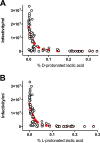Anti-HIV-1 Activity of Lactic Acid in Human Cervicovaginal Fluid
- PMID: 29976641
- PMCID: PMC6034077
- DOI: 10.1128/mSphere.00055-18
Anti-HIV-1 Activity of Lactic Acid in Human Cervicovaginal Fluid
Abstract
Women of reproductive age with a Lactobacillus-dominated vaginal microbiota have a reduced risk of acquiring and transmitting HIV and a vaginal pH of ~4 due to the presence of ~1% (wt/vol) lactic acid. While lactic acid has potent HIV virucidal activity in vitro, whether lactic acid present in the vaginal lumen inactivates HIV has not been investigated. Here we evaluated the anti-HIV-1 activity of native, minimally diluted cervicovaginal fluid obtained from women of reproductive age (n = 20) with vaginal microbiota dominated by Lactobacillus spp. Inhibition of HIVBa-L was significantly associated with the protonated form of lactic acid in cervicovaginal fluid. The HIVBa-L inhibitory activity observed in the <3-kDa acidic filtrate was similar to that of the corresponding untreated native cervicovaginal fluid as well as that of clarified neat cervicovaginal fluid subjected to protease digestion. These ex vivo studies indicate that protonated lactic acid is a major anti-HIV-1 metabolite present in acidic cervicovaginal fluid, suggesting a potential role in reducing HIV transmission by inactivating virus introduced or shed into the cervicovaginal lumen.IMPORTANCE The Lactobacillus-dominated vaginal microbiota is associated with a reduced risk of acquiring and transmitting HIV and other sexually transmitted infections (STIs). Lactic acid is a major organic acid metabolite produced by lactobacilli that acidifies the vagina and has been reported to have inhibitory activity in vitro against bacterial, protozoan, and viral STIs, including HIV infections. However, the anti-HIV properties of lactic acid in native vaginal lumen fluids of women colonized with Lactobacillus spp. have not yet been established. Our study, using native cervicovaginal fluid from women, found that potent and irreversible anti-HIV-1 activity is significantly associated with the concentration of the protonated (acidic, uncharged) form of lactic acid. This work advances our understanding of the mechanisms by which vaginal microbiota modulate HIV susceptibility and could lead to novel strategies to prevent women from acquiring HIV or transmitting the virus during vaginal intercourse and vaginal birth.
Keywords: HIV transmission; Lactobacillus; human immunodeficiency virus; metabolite; microbiota; vagina.
Copyright © 2018 Tyssen et al.
Figures






References
-
- Gosmann C, Anahtar MN, Handley SA, Farcasanu M, Abu-Ali G, Bowman BA, Padavattan N, Desai C, Droit L, Moodley A, Dong M, Chen Y, Ismail N, Ndung'u T, Ghebremichael MS, Wesemann DR, Mitchell C, Dong KL, Huttenhower C, Walker BD, Virgin HW, Kwon DS. 2017. Lactobacillus-deficient cervicovaginal bacterial communities are associated with increased HIV acquisition in young South African women. Immunity 46:29–37. doi: 10.1016/j.immuni.2016.12.013. - DOI - PMC - PubMed
-
- Borgdorff H, Tsivtsivadze E, Verhelst R, Marzorati M, Jurriaans S, Ndayisaba GF, Schuren FH, van de Wijgert JH. 2014. Lactobacillus-dominated cervicovaginal microbiota associated with reduced HIV/STI prevalence and genital HIV viral load in African women. ISME J 8:1781–1793. doi: 10.1038/ismej.2014.26. - DOI - PMC - PubMed
Publication types
MeSH terms
Substances
Grants and funding
LinkOut - more resources
Full Text Sources
Other Literature Sources
Miscellaneous
